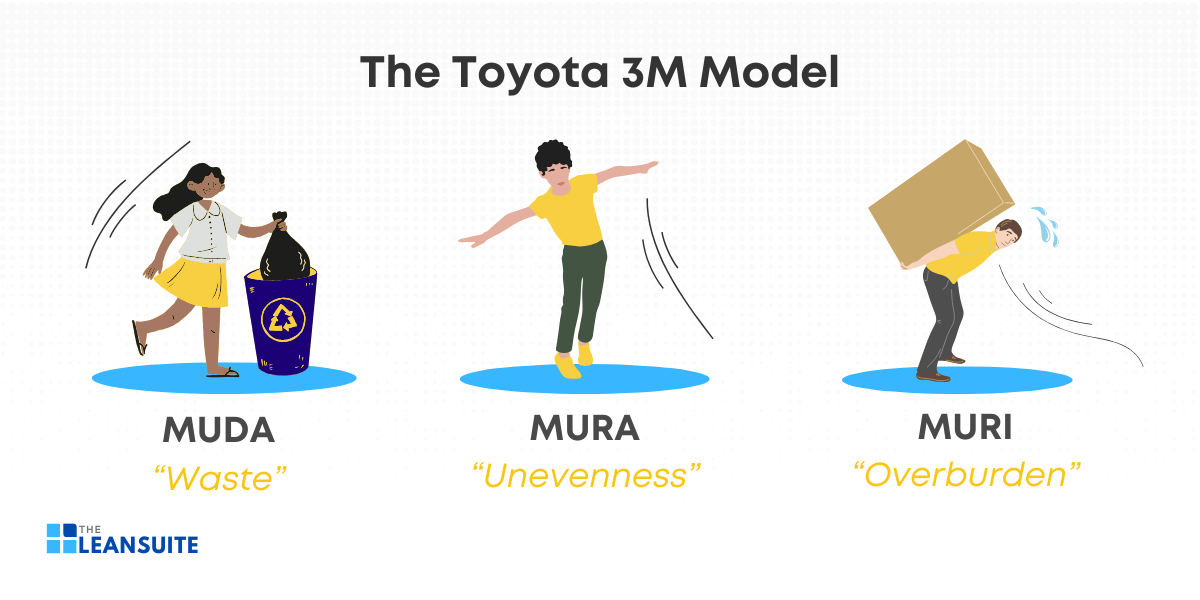Muda, Mura, Muri (The Toyota 3M Model): A Quick Introduction
The Toyota Production System has long been celebrated as the best example of efficiency and innovation in the manufacturing industry. Central to this system are the concepts of Muda, Mura, and Muri, which are collectively known as the Toyota 3M Model.
By understanding and addressing these three elements, you can streamline your operations, reduce inefficiencies, and enhance productivity. In this blog post, we will explore Muda, Mura, and Muri and see how their elimination can lead to optimized processes and a more agile organization, much like the one Toyota has successfully implemented for decades.
Understanding the Toyota Production System
The Toyota Production System (TPS) is a revolutionary management philosophy designed to eliminate waste and maximize value-added activities across all levels of production. In fact, it serves as the foundational framework for Lean process management, a business methodology that has been widely adopted across various industries around the world.
At its core, TPS emphasizes the importance of continuous improvement, also known as “Kaizen.” It also empowers employees by involving them actively in problem-solving and decision-making processes. Essentially, this approach strives for operational excellence and fosters a collaborative and innovative workplace culture. As a result, this enables you to achieve sustained efficiency and higher quality in your production processes.
Identifying inefficiencies in business processes
Identifying inefficiencies in business processes is important for optimizing productivity and achieving operational excellence. Inefficiencies can be categorized into three main types:
- Muda (waste)
- Mura (unevenness)
- Muri (overburden)
Muda refers to activities that do not add value to the production process. For example, unnecessary movement, waiting, or holding excess inventory. These elements can drain resources and impact productivity. Mura, on the other hand, signifies inconsistency or unevenness within the production process. Therefore, creating bottlenecks and disruptions that lead to inefficiencies. Finally, Muri represents overburden or excessive workload, which can strain resources, increase the likelihood of errors, and contribute to employee burnout.
By systematically identifying and addressing these inefficiencies, you can streamline your operations, enhance quality, and foster a more agile and resilient organizational structure that is better equipped to adapt to changing market demands.
The Toyota 3M Model: What is Muda, Mura, Muri?

1. Muda (Waste)
The first M of the Toyota 3M model is Muda. It is also known as waste and is any activity or process that consumes resources without adding value. Muda reduction is essential as it not only eliminates non-value-adding activities, but also enhances overall operational efficiency.
The eight wastes, often summarized by the acronym DOWNTIME, provide a framework for identifying areas of improvement:
- Defects: Errors or rework that compromise quality
- Overproduction: Producing more than what is needed
- Waiting: Delays in the production line that stall progress
- Non-utilized talent: The underutilization of employees’ skills and expertise
- Transportation: Unnecessary movements of materials that do not contribute to value
- Inventory: Holding excess stock that ties up resources
- Motion: Unnecessary movements by employees that do not add value
- Excess Processing: Doing more work than necessary
By systematically eliminating these wastes, you can achieve increased efficiency and significant cost reductions. Ultimately, improving customer satisfaction due to better-quality products and services delivered in a timely manner.
2. Mura (Unevenness)
Managing Mura is crucial because it is often the root cause of Muda. Mura represents unevenness or inconsistencies and can lead to operational disruptions. For instance, delays, overproduction, or periods of inactivity. These disruptions compromise overall efficiency and impact the smooth flow of production processes.
By focusing on managing Mura, you can aim to standardize and harmonize your operations. Thus, effectively minimizing these inconsistencies. This proactive approach not only enhances production line efficiency, but also helps you consistently meet targets. Thereby, improving reliability and customer satisfaction.
In short, managing Mura lays the foundation for a more streamlined and resilient production environment. Consequently, reducing waste and enhancing productivity.
3. Muri (Overburden)
Preventing Muri, or overburden, is essential to creating a balanced and sustainable work environment. Muri often arises from Mura, the unevenness in processes, and can also result from excessive removal of Muda. This is because efforts to eliminate waste might inadvertently overload employees and equipment.
By striving to prevent Muri, you can avoid the pitfalls of unrealistic expectations and poor planning. Both of which can significantly impact employee well-being and equipment performance.
Overloading workers or machinery risks efficiency and productivity, and jeopardizes health and safety. So, by fostering a balanced workload, you can promote sustainable productivity and ensure that both human and mechanical resources operate optimally. What’s more, you can enhance employee morale, boost efficiency, and maintain the longevity of your equipment.
The benefits of eliminating Muda, Mura, Muri
Eliminating Muda, Mura, and Muri from business operations offers numerous benefits that can transform your organization into a more efficient, cost-effective, and customer-centric entity.
By systematically addressing these inefficiencies, you can optimize your production processes which can lead to increased efficiency and reduced costs. This optimization not only improves distribution center efficiency, but also minimizes inventory waste as it ensures resources are used effectively. These improvements strengthen your company’s competitiveness in the marketplace by allowing you to provide higher-quality products and services in a timely manner.
Furthermore, eliminating these three concepts is integral to achieving operational excellence. This is because there is a focus on maximizing value-added activities and fostering a culture of continuous improvement. This approach ultimately enhances customer satisfaction by consistently meeting or exceeding expectations. Thus, solidifying your company’s reputation and market position.
Conclusion
In conclusion, embracing Muda, Mura, Muri is essential for any organization aiming to eliminate waste and optimize production processes. By thoroughly understanding and applying these three essential concepts, this allows you to achieve operational excellence and significantly enhance customer satisfaction by delivering higher quality and value.
The Toyota Production System, alongside the Lean production philosophy, offers a robust framework for implementing these initiatives. Therefore, paving the way for sustainable success. By continuously focusing on these strategies, you can maximize value-added activities, maintain a competitive edge, and foster a culture of innovation and improvement that pushes you towards a more agile and efficient future.





